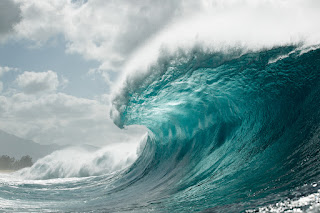“Surfing
evokes in us a deep connection with our soul and identifies something that is
beyond imagination, beyond words,” writes Morning
Of The Earth director Albert Falzon.
It’s a sentiment which sums up to a tee the feeling, the essence, the
spirit captured in his groundbreaking cult film which February just gone,
celebrated its 40th anniversary.
 |
| Hawaii, early this year. Pic by Jon Frank. |
“It’s a
journey, you can’t plan for it,” Kidman muses on what the pair have come up
with so far. “We’re three or four
months into it and what’s been one of the most interesting parts, is working
through the ideas you have and going, ‘Well, that’s really the spirit right
there’, or, ‘That isn’t’. That’s
to do with how things sound, how things are filmed… and it also has to do with
the people you end up working with.
And I think that’s how it has to be… the people who are involved in it,
whether they’re musicians or surfers or whatever, they’ve really got to
understand what that film was,
because if they don’t, I don’t think it’ll transcend into the new film.”
Kidman is
responsible for, among other things, the films Litmus (1996) and Glass Love
(2006), and fronts The Windy Hills, who soundtrack surf films live, and who
will contribute to the upcoming Spirit Of
Akasha soundtrack. He was
approached last year by Falzon and executive producer Chris Moss, but given
he’s grown up with MOTE, he
understandably had some initial reservations about the whole project.
“Well, I was
nervous,” he smiles, sitting on the step of his van on a property out the back
of Mullumbimby on the NSW north coast.
“For me, MOTE was such an
iconic piece of filmmaking. Along
with the music it’s such a part of our culture. To assume that you can do something like that [again]… I
wasn’t sure about it. But at the
same time, I was like, ‘It’ll be a real challenge to try to make something like
that today’, so much has changed.”
“But in the
same sense, so much hasn’t changed,”
he quickly adds. “I mean, you
still go down the beach and have a surf.
I really think the spirit of surfing is still there everyday if you just
wanna paddle out and enjoy whatever part of that it is that you do, and I think
MOTE was that. Surfing has changed so much and it’s
changed so many things about the world, but in its essence, it hasn’t changed.”
The question
remains then, how do you go about capturing that? When Falzon made his film in 1972, professional surfing
didn’t exist, the first pro surf event wasn’t held until around a year later –
surfing is an industry now. As well, the original locations in Bali
and Hawaii are vastly different to how they were four decades ago, the world is a different place. So can the Earth be born again?
 |
| Hawaii, early this year. Pic by Jon Frank. |
As far as content for Spirit Of Akasha goes, Kidman is tight-lipped, refusing to reveal
which surfers they’ll be filming (“It’s part of the surprise,” he smiles), or
which bands will be contributing to the soundtrack, almost as important a part
of the film as the visual footage.
Thus far they’ve spent time in Hawaii and the east coast of Australia,
there are no plans to return to Bali.
It’s an ongoing project, with a tentative release date of early next
year, striving to re-capture a primal spirit which exists on an untamed
frontier, within the confines of a tightly controlled, rule-fuelled world;
perhaps one of the most primitive pastimes still available to a human being.
“It gives to
us love and beauty, unconditionally, and asks nothing in return,” Falzon
writes. “When you ride a wave, you
enter another zone, a place so peaceful and perfect, a place you know so well,
a place beyond any realm in the outside world. Timeless and formless – where
everything is so perfect – you want nothing else. Riding a wave is the magnetic
attraction that keeps us linked to other worlds.” Falzon caught this on film 40 years ago. It’s this spirit that must channel through to Spirit Of Akasha in order to keep it
true, to keep the essence alive.
Samuel J. Fell


No comments:
Post a Comment